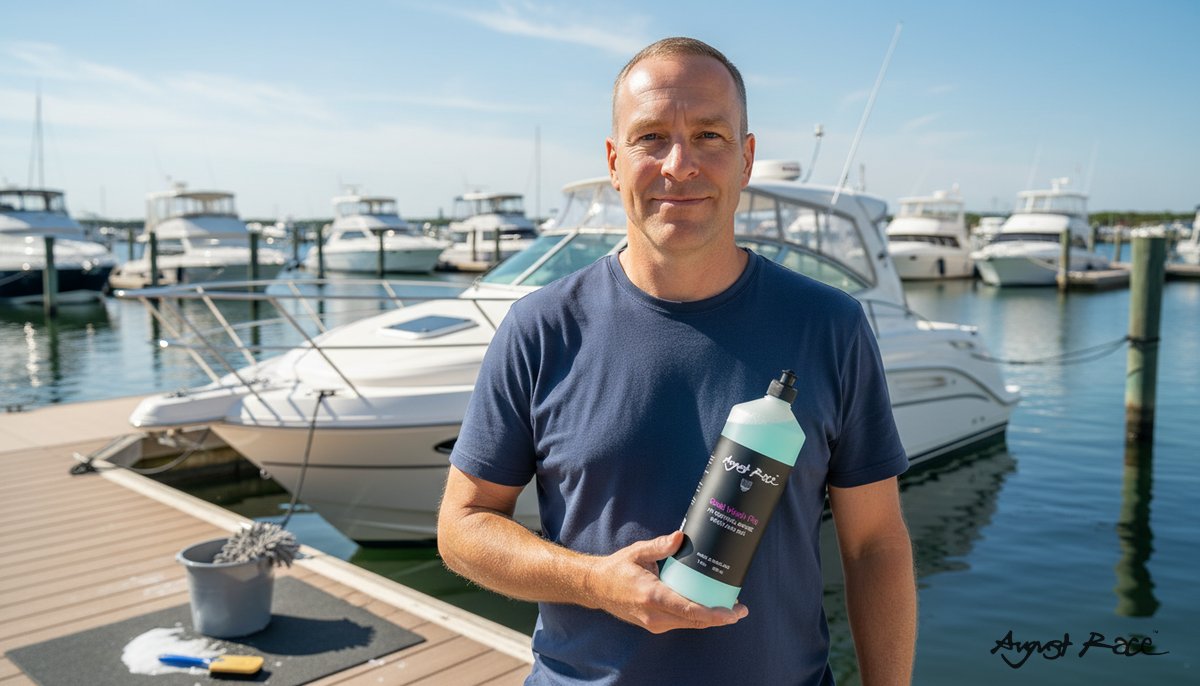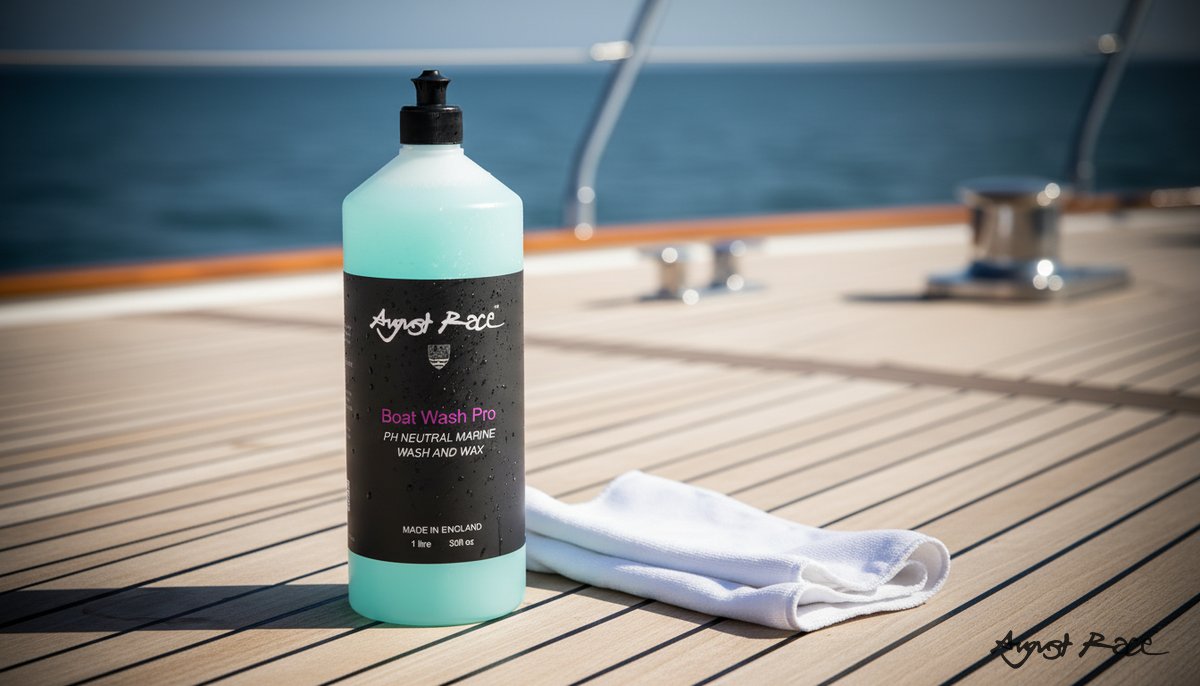Protect Your Gelcoat: Remove Salt Buildup and Algae with August Race Boat Wash Pro
I still remember the morning I walked down the dock after a lively weekend offshore. The sunrise hit the hull just right -- and there it was. A dull, chalky film of salt buildup along the waterline and faint green streaks trailing from the scuppers. My pride dipped. It wasn’t just about looks; it was a reminder that nature never stops working on our boats, even when we’re ashore.
Beyond the dent to the ego, I worried about the gelcoat. Would this lead to more buffing, more cost, and, eventually, less shine when it came time to sell? I promised myself I’d tighten up my routine and find a smarter way forward -- something that kept the boat’s finish flawless without turning every weekend into a detailing marathon. That’s when I started researching better cleaning habits and products. In that search, August Race Boat Wash Pro changed how I approach regular care -- especially for algae removal and persistent salt residue -- without turning maintenance into a production.
If you’ve been searching for "how to remove salt buildup on boat gelcoat" or the "best algae remover for boats," you’re not alone. I asked the same questions -- and found answers that actually fit a yacht owner’s routine.
What salt buildup and algae really do to gelcoat -- in plain owner language
Think of dried salt like ultrafine sandpaper. When saltwater evaporates, it leaves crystals behind. If you don’t remove them properly, they sit on the gelcoat and, with each contact -- feet, lines, fenders -- can lightly scour the finish. Over time, that robs the surface of the deep gloss we all pay to protect.
Algae is a different enemy. It clings and stains, especially at the waterline, steps, and swim platforms. On deck, it can turn surfaces slick. It’s not just cosmetic; it’s a safety issue when guests are aboard.
Here’s why that matters to owners:
- Dullness creeps in faster, and polishing becomes more frequent -- and more expensive.
- Stains can settle in, making future cleans longer and harsher on the finish.
- Resale impressions suffer when the hull loses that showroom look.
I used to think a quick freshwater rinse was enough. It helps, but it won’t always dissolve embedded crystals or lift bio-staining. Rinsing alone often leaves behind faint rings and streaks that set up the next round of trouble. That’s when a purpose-built gelcoat cleaner earns its keep.
My priorities became simple: the product had to be effective, gelcoat-safe, and easy enough to use that I’d actually keep the routine.
Choosing a gelcoat-safe cleaner: what mattered when I tested products
After trying a handful of solutions, these criteria rose to the top for everyday boat cleaning:
- Non-abrasive formula that won’t haze the gelcoat
- Real muscle against salt deposits
- Effective algae removal without harsh scrubbing
- Streak-free finish when rinsed and dried
- Straightforward application so it fits an owner’s routine
I also wanted an eco-aware approach. We’re guests in our marinas, and what we use flows right into the water where we keep our boats. Keeping the peace with dock neighbors -- and protecting our home waters -- matters.
Portability counted too. I like products I can use on the big boat and toss in a tote for the tender. Many of us run RIBs, and a solution that plays well there is a practical bonus. If you prioritize an "eco-friendly boat wash for RIBs," check the label for Hypalon/PVC compatibility.
In the end, August Race Boat Wash Pro lined up with those owner-first criteria. No heavy tech talk -- just a gelcoat cleaner that cleans well, leaves a bright, even finish, and doesn’t demand a full day to use.
How I used August Race Boat Wash Pro step-by-step (salt, algae, and keeping that showroom shine)
Here’s the routine that gave me reliable results and a truly "streak-free boat cleaning solution" finish.
- Prep the workspace
- Work in the shade if you can. Direct sun dries product too fast and can cause spotting.
- Do a gentle freshwater rinse to knock off loose grit. Start high, rinse low.
- Lay out a soft brush, microfiber wash mitts, two buckets (wash and rinse), and a drying towel.
- Mix as directed
- Follow the label instructions for dilution. I mix fresh each wash so the solution stays effective.
- For stubborn salt crust or light algae staining, I keep a small spray bottle of slightly stronger mix for spot treatment.
- Apply top-down in small sections
- Wet the area, then apply the solution with a microfiber mitt or soft brush.
- Let it dwell briefly so it can dissolve salt crystals and loosen algae. Don’t let it dry on the surface.
- For seams, around hardware, and at the waterline, I use a soft detailing brush and a gentle touch.
- Agitate without abrasion
- Use light pressure. Let the cleaner do the work.
- On textured decks or swim platforms, a soft brush lifts growth without scuffing the finish.
- If you’re working on a RIB, confirm material compatibility on the label (Hypalon/PVC) and test a small spot first. For deeper RIB tube cleans between washes, consider a dedicated option like Liquid RIB cleaner.
- Rinse for a streak-free result
- Rinse thoroughly from the top down. Keep the hose moving to push soap and residue off the boat instead of letting it sit.
- If your water is hard, a final rinse with filtered water helps minimize spots.
- Dry and check the gloss
- Blot or sheet-dry with a clean microfiber towel.
- Walk the hull and deck in changing light. If you see a faint ring or shadow, a quick spot pass usually clears it.
Troubleshooting tips
- Stubborn waterline stain: Pre-treat with a slightly stronger mix, allow a longer dwell time, and agitate gently. Repeat rather than scrubbing hard.
- After a salty run: Tackle the bow and windward side first -- the worst salt buildup often sits there.
- RIBs and tenders: Keep a small kit onboard. A quick wash after beach landings stops grit and salt from embedding. To preserve tube finish after cleaning, a UV coating like LR Sealer UV helps.
- When to call a pro: If you’re seeing deep staining or oxidation that doesn’t respond to cleaning, it’s time for a professional detail and possibly a polish, then sealant or wax.
Once I settled into this routine, I found I could wash faster, use less elbow grease, and still step back to that crisp, even gloss that feels “showroom” without being slick.
Real results: before-and-after, longevity, and why this felt worth the investment
My first full wash with August Race Boat Wash Pro delivered the kind of changes you notice from the dock:
- The white salt rings along the boot stripe disappeared.
- Green algae streaks at the scuppers lifted cleanly.
- The gelcoat’s shine looked uniform from bow to stern, not patchy.
Across the season, I spent less time spot-cleaning and postponed polishing. The finish held its depth because I wasn’t grinding in residue or chasing stains with abrasive pads. For me, that’s real value: fewer minor fixes, less product waste, and a boat that always looks ready for guests.
Compared to the methods I tried:
- Plain freshwater rinse: Helpful but left behind faint salt and waterline shadows that reappeared after drying.
- Abrasive cleaners: Quick win in spots, but they dulled my gloss and made me pay it back with compound later.
- Boat Wash Pro: Gentle on the finish yet strong enough to clear the films that cause the most frustration.
If you’ve been searching for the best algae remover for boats, the point isn’t a single miracle ingredient; it’s a balanced, gelcoat-safe formula that loosens growth without hammering your finish. That’s what made the difference for me.
Safety, marina rules, and eco-friendly care for conscientious owners
A few owner-to-owner notes:
- Material safety: Use soft tools and the recommended dilution. The wash played well with my gelcoat, stainless, and vinyl. Always test a small, inconspicuous area first -- especially on sensitive trim or RIB materials.
- Eco-aware habits: Favor products intended for marine use and follow the label. It reflects well on you and protects the waters we all share.
- Marina etiquette: Check your dock’s rules. Some marinas ask you to minimize runoff, avoid harsh chemicals, or capture rinse water in certain areas.
- RIBs and tenders: An eco-friendly boat wash for RIBs that you also trust on the mothership makes kits simpler and keeps your whole fleet consistent.
Good stewardship is part of ownership. A clean boat that’s cared for responsibly says a lot about the captain.
Quick maintenance schedule: keep your gelcoat showroom-ready with minimal fuss
Here’s the cadence that keeps my finish high and my workload low:
Weekly
- Quick freshwater rinse, especially after open-water runs.
- Fast mitt wash on high-impact areas (bow, waterline, transom).
Monthly
- Full wash with August Race Boat Wash Pro for a consistent, streak-free result.
- Spot-treat any developing stains before they set.
Quarterly
- Inspect for micro-scratches and oxidation. If needed, polish and reapply your preferred sealant or wax -- options like GRP Sealer UV and Smooth Opacity UV wax help maintain gloss and protection.
- Touch up fender covers and lines that might be transferring dirt.
After heavy salt exposure (storm or long run)
- Rinse promptly while the salt is fresh.
- Address the windward side and bow first, where buildup is worst.
Tools to keep aboard
- Microfiber towels and mitts
- Soft brush and small detailing brush
- Two buckets (wash and rinse)
- A spray bottle with diluted wash for quick spot work
A simple maintenance log helps: note dates, products, and any problem spots. It protects warranties and shows future buyers you cared for the finish methodically.
Ready to protect your investment? Where to get August Race Boat Wash Pro and how to try it
If you’re ready to upgrade your routine, start with a single bottle or a basic kit of August Race Boat Wash Pro. You can find it through reputable marine retailers and trusted online shops, or directly via the August Race shop to browse August Race products.
An easy first test: take on one small area with visible salt buildup -- say, a waterline ring or a scupper streak. Do a careful before/after comparison. The difference in one session tells you most of what you need to know.
Share results with your dock neighbors and crew. The right gelcoat cleaner doesn’t just keep the boat beautiful; it saves time you’d rather spend underway. If you’re buying online, review the store’s return policy for peace of mind.
Your yacht deserves that first-look shine every time you step aboard. With a smart routine and the right product, you’ll protect the finish, the experience, and the value -- without turning boat cleaning into a full-time job.
FAQs: quick answers for yacht owners
How to remove salt buildup on boat gelcoat without damaging the finish?
Rinse the area, then wash with a gelcoat-safe cleaner like August Race Boat Wash Pro mixed per the label. Allow brief dwell time to dissolve crystals, agitate gently with a soft mitt, and rinse thoroughly before drying with microfiber to prevent spotting.
What is the best algae remover for boats that is safe for gelcoat?
The best algae remover for boats loosens growth without abrasion and rinses clean for an even gloss. August Race Boat Wash Pro fits that need with a balanced, gelcoat-safe formula that lifts algae while protecting the finish when used as directed.
Is there an eco-friendly boat wash suitable for RIBs that gives a streak-free finish?
Look for a marine-intended, eco-aware wash and confirm material compatibility for your RIB (Hypalon or PVC). Used correctly, Boat Wash Pro can deliver a streak-free result on both the mothership and tenders -- test a small area first and avoid working in direct sun.
How often should I use a gelcoat cleaner to prevent salt and algae stains?
Lightly rinse after each outing and do a full wash monthly during the season, or more often after heavy exposure. If you see early signs of staining, spot-clean right away so you avoid aggressive scrubbing or premature polishing later.
If you’ve been wondering about an "eco-friendly boat wash for RIBs" or how to get that "streak-free boat cleaning solution" finish, start small, stay consistent, and let a better routine do the heavy lifting for your shine and your resale value.
About the Author
Maria Chen
The Discerning Yacht Owner
Owner of a 52-foot Azimut yacht and former marine biology professor. Maria is meticulous and has become an expert in efficient and effective boat maintenance solutions through personal necessity and scientific curiosity.
Expertise:
Get Expert Tips
Subscribe for marine care insights and product updates from industry professionals.
No spam. Unsubscribe anytime.
You May Also Like

Stop Gelcoat Water Spots with August Race GRP Sealer UV
Protect your hull from gelcoat water spots and rain oxidation. See how August Race GRP Sealer UV delivers hydrophobic gloss and UV defense with easy DIY.

Can faded fiberglass be restored? | August Race
Yes, faded GRP often responds to cleaning, compounding, polishing, and a UV sealer. Learn when to restore and how GRP Sealer UV protects.

Salt Removal Boat Care with August Race Boat Wash Pro
Cut saltwater stains and gelcoat grime fast. pH-neutral, biodegradable wash for fleets, RIBs, and yachts -- save rinse cycles at your marina.
